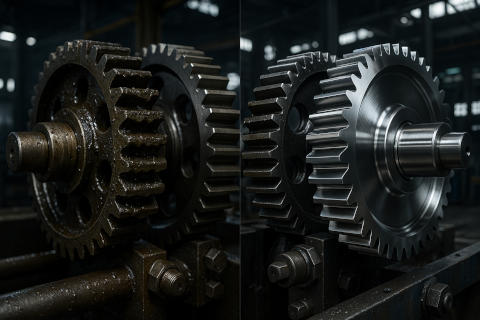Recent Advancements In The Development Of Industrial Gear Oil For Steel Plant Gear Drives
 Understanding Gear Failures and Limitations of Standard Lubricants
Understanding Gear Failures and Limitations of Standard Lubricants
Standard industrial gear lubricants with Sulphur and Phosphorus as EP additives do not actively combat wear. Under challenging operating conditions, issues like microcracks, micropitting, sharp edges, or pitting (material breakouts) can occur—leading to gear failure and production downtime.
Prolonging Gear Life with Anti-Micropitting Gear Oils
Anti-micropitting gear oils allow previously damaged gears to continue functioning— sometimes for several years—until a replacement is available. These oils have been developed through collaboration with gearbox manufacturers and research institutes, offering benefits like increased lifespan, improved safety, and cost savings.
Technology Behind High-Performance Gear Oils
New formulations, such as the Eutectic Formula, ensure optimal performance even under extreme loads and temperatures. These oils provide maximum wear protection, even under the toughest conditions like wind power generation.
What Causes Micropitting?
Factors such as oil film thickness, temperature, and slide-to-roll ratio contribute to micropitting. This wear appears as a dull, gray finish, caused by surface fatigue. It alters the gear tooth profile, creating noise, vibration, and misalignment.
Combating Oil Ageing in Industrial Gearboxes
Oil ageing accelerates with temperature— doubling with every 10°C rise. Anti-micropitting gear oils help reduce oil temperature and ageing by using advanced additives with low friction coefficients.
Role of Advanced Additives in Wear Protection
These additives help adapt to changing loads, increasing the load-carrying capacity and smoothing out pre-damaged surfaces. Lower friction improves efficiency and reduces energy consumption.
Advantages of Anti-Micropitting Gear Oils
- Active wear protection
- Lower maintenance costs and extended oil change intervals
- Increased energy efficiency
- Smoothing of pre-damaged surfaces
- Longer gear and component life
Applications of High-Performance Industrial Gear Oils
These oils are suitable for nearly all enclosed industrial gears—especially in conditions of:
- High loads
- Variable speeds
- Thermal stress
They are also recommended for:
- Bearings
- Gear couplings
- Slideways
- Circulating systems
- Flender gears (approved use)
Technical Specifications
- Viscosity Grades: ISO VG 100 to ISO VG 680
- Base Oils: Mineral / Synthetic (PAO)
- Standards: ISO 12925-1, DIN 51517-3 (CLP), DIN ISO 3448, ANSI/AGMA 9005 – F16
Performance Highlights
- Prevents micropitting and pitting
- Superior wear and corrosion protection
- Reduces noise, oil sump temperature, and energy consumption
- Resmooths damaged surfaces
Typical Parameters (ISO VG 680)
- Viscosity @ 40°C: 655 mm²/s
- Viscosity @ 100°C: 40 mm²/s
- Density: 0.912 kg/m³
- Flash Point: 230°C
- Pour Point: 0°C
- FVA No. 54 P: >10
- FZG Test: >12
Managing Water Contamination and Foam
Wet oil promotes micropitting—possibly due to hydrogen embrittlement. These oils resist water contamination and foam formation using special inhibitors and selected base components, minimizing corrosion risks.
Debris-Related Wear and Required Cleanliness Standards
Debris in the oil can dent gear teeth, causing micropitting. Dent shape and depth vary with debris type. Proper cleanliness must be ensured during gear assembly and service to prevent damage.
| Oil Sample Source | Required Cleanliness (ISO 4406) |
|---|---|
| New oils before filling | 16/14/11 |
| Gearbox after factory testing | 17/15/12 |
| Gearbox during service | 18/16/13 |
Product Description and Characteristics
Anti-Micropitting Gear Oil is a high-performance product based on mineral/synthetic (PAO) oils with advanced Eutectic additive technology. Suitable for a wide range of industrial applications from -10°C to +100°C.
Key Characteristics:
- Excellent wear and corrosion protection
- Reduces friction and oil temperature
- Silicone- and solid-free
Advantages and Benefits
- Prevents micropitting and pitting
- Smoothens damaged surfaces
- Extends service life
- Handles low-speed, high-load conditions
- Enables longer oil change intervals
- Suitable for all bearing and filter systems
